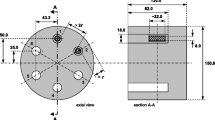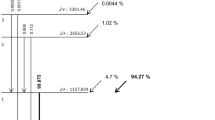Abstract
Purpose
This study evaluated the absolute quantification of iodine-124 (124I) activity concentration with respect to the use of this isotope for dosimetry before therapies with 131I or 131I-labeled radiotherapeuticals. The recovery coefficients of positron emission tomography(/computed tomography) PET(/CT) systems using 124I were determined using phantoms and then validated under typical conditions observed in differentiated thyroid cancer (DTC) patients.
Methods
Transversal spatial resolution and recovery measurements with 124I and with fluorine-18 (18F) as the reference were performed using isotope-containing line sources embedded in water and six isotope-containing spheres 9.7 to 37.0 mm in diameter placed in water-containing body and cylinder phantoms. The cylinder phantom spheres were filled with 18F only. Measurements in two-dimensional (2D) and three-dimensional (3D) modes were performed using both stand-alone PET (EXACT HR+) and combined PET/CT (BIOGRAPH EMOTION DUO) systems. Recovery comparison measurements were additionally performed on a GE ADVANCE PET system using the cylinder phantom. The recovery coefficients were directly determined using the activity concentration of circular regions of interest divided by the prepared activity concentration determined by the dose calibrator. The recovery correction method was validated using three consecutive scans of the body phantom under our 124I PET(/CT) protocol for DTC patients.
Results
Compared with that of 18F, transversal spatial resolution of 124I was slightly, but statistically significantly degraded (7.4 mm vs. 8.3 mm, P<0.002). Using the body phantom, recovery was lower for 124I than for 18F in both 2D and 3D modes. The 124I recovery coefficient of the largest sphere was significantly higher in 2D than in 3D mode (81% vs. 75%, P=0.03). Remarkably, the 18F recovery coefficient for the largest sphere significantly deviated from unity (range of 87%–93%, P<0.004) for all scanners but the GE ADVANCE. The maximum range of inaccuracy of the measured 124I activity concentration under in vivo conditions after applying partial volume correction was ±10% for spheres ≥12.6 mm in diameter.
Conclusions
Recovery correction is mandatory for 124I PET quantification, even for large structures. To ensure accurate dosimetry, thorough absolute recovery measurements must be individually established for the particular PET scanner and radionuclide to be used.







Similar content being viewed by others
References
Erdi YE, Macapinlac H, Larson SM, Erdi AK, Yeung H, Furhang EE, et al. Radiation dose assessment for I-131 therapy of thyroid cancer using I-124 PET imaging. Clin Positron Imaging 1999;2:41–6.
Eschmann SM, Reischl G, Bilger K, Kupferschläger J, Thelen MH, Dohmen BM, et al. Evaluation of dosimetry of radioiodine therapy in benign and malignant thyroid disorders by means of iodine-124 and PET. Eur J Nucl Med 2002;29:760–7.
Sgouros G, Kolbert KS, Sheikh A, Pentlow KS, Mun EF, Barth A, et al. Patient-specific dosimetry for I-131 thyroid cancer therapy using I-124 PET and 3-dimensional-internal dosimetry (3D-ID) software. J Nucl Med 2004;45:1366–72.
Freudenberg LS, Bockisch A, Jentzen W. Iodine-124 PET dosimetry and PET/CT imaging in differentiated thyroid cancer. In: Biersack HJ, Grünwald F, editors. Thyroid cancer. Heidelberg - New York: Springer Verlag, 2005. 127–38.
Bockisch A, Freudenberg L, Rosenbaum S, Jentzen W. I-124 in PET imaging: impact on quantification, radiopharmaceutical development and distribution. Eur J Nucl Med Mol Imaging 2006;33:1247–8.
Freudenberg L, Jentzen W, Görges R, Petrich T, Marlowe RJ, Knust J, et al. I-124 PET dosimetry in advance differentiated cancer. Nuklearmedizin 2007;46:121–8.
Hoffmann EJ, Huang SC, Phelps ME. Quantitation in positron emission tomography: 1. Effect of object size. J Comput Assist Tomogr 1979;3:299–308.
Kessler RM, Ellis JT Jr, Eden M. Analysis of emission tomographic scan data: limitations imposed by resolution and background. J Comput Assist Tomogr 1984;8:514–22.
Geworski L, Knoop BO, Levi de Cabrejas M, Knapp WH, Munz DL. Recovery correction for quantification in emission tomography: a feasibility study. Eur J Nucl Med 2000;27:161–9.
Beattie BJ, Finn RD, Rowland DJ, Pentlow KS. Quantitative imaging of bromine-76 and yttrium-86 with PET: a method for the removal of spurious activity introduced by cascade gamma rays. Med Phys 2003;30:2410–23.
Herzog H, Tellmann L, Qaim SM, Spellberg S, Schmid A, Coenen HH. PET quantitation and imaging of the non-pure positron-emitting iodine isotope I-124. Appl Radiat Isot 2002;56:673–9.
Pentlow KS, Graham MC, Lambrecht RM, Cheung NK, Larson SM. Quantitative imaging of I-124 using positron emission tomography with applications to radioimmunodiagnosis and radioimmunotherapy. Med Phys 1991;18:357–66.
Pentlow KS, Graham MC, Lambrecht RM, Daghighian F, Bacharach SL, Bendriem B, et al. Quantitative imaging of iodine-124 with PET. J Nucl Med 1996;37:1557–62.
Robinson S, Julyan PJ, Hastings DL, Zweit J. Performance of a block detector PET scanner in imaging non-pure positron emitters - modeling and experimental validation with I-124. Phys Med Biol 2004;49:5505–28.
Knust EJ, Dutschka K, Weinreich R. Preparation of I-124 solutions after thermodistillation of irradiated 124TeO2 targets. Appl Radiat Isot 2000;52:181–4.
Weinreich R, Knust EJ. Quality assurance of iodone-124 produced via the nuclear reaction 124Te(d, 2n)124I. J. Radioanal Nucl Chem Lett 1996;213:253–61.
Adam LE, Zaers J, Ostertag H, Trojan H, Bellemann ME, Brix G. Performance evaluation of the whole-body PET scanner ECAT EXACT HR+ following the IEC standard. IEEE Trans Nucl Sci 1997;44:1172–9.
Beyer T, Townsend DW, Brun T, Kinahan PE, Charron M, Roddy R, et al. A combined PET/CT scanner for clinical oncology. J Nucl Med 2000;41:1369–79.
DeGrado TR, Turkington TG, Williams JJ, Stearns CW, Hoffman JM, Coleman RE. Performance characteristics of a whole-body PET scanner. J Nucl Med 1994;35:1398–406.
Lewellen TK, Kohlmyer SG, Miyaoka RS, Kaplan MS, Stearns CW, Schubert SF. Investigation of the performance of the General Electric ADVANCE positron emission tomograph in 3D mode. IEEE Trans Nucl Sci 1996;43:2199–206.
Schötzig, U. und Schrader, H.: Halbwertszeiten und Photonen-Emissionswahrscheinlichkeiten von häufig verwendeten Radionukliden. PTB-Bericht PTB-Ra-16/5, Braunschweig, 2000.
National Electric Manufactures Association. NEMA Standards Publication NU 2-2001: Performance measurements of positron emission tomographs. 2001; 1–40. Rosslyn, VA, National Electric Manufactures Association. NEMA Standards Publication NU 2-2001.2001.
International Standard IEC 61675-1: Radionuclide imaging devices - characteristics and test conditions - Part 1: Positron emission tomographs. International Eletrotechnical Commission. Geneva, 1998.
Knoop BO, Geworski L, Hofmann M, Munz DL, Knapp WH. Use of recovery coefficients as a test of system linearity of response in positron emission tomography. Phys Med Biol 2002;47:1237–54.
Levin CS, Hoffman EJ. Calculation of positron range and its effect on the fundamental limit of positron emission tomography system spatial resolution. Phys Med Biol 1999;44:781–99.
Ramos CD, Erdi YE, Gonen M, Riedel E, Yeung HW, Macapinlac HA, et al. FDG-PET standardized uptake values in normal anatomical structures using iterative reconstruction segmented attenuation correction and filtered back-projection. Eur J Nucl Med 2001;28:155–64.
Schoder H, Erdi YE, Chao K, Gonen M, Larson SM, Yeung HW. Clinical implications of different image reconstruction parameters for interpretation of whole-body PET studies in cancer patients. J Nucl Med 2004;45:559–66.
Lubberink M, Schneider H, Bergstrom M, Lundqvist H. Quantitative imaging and correction for cascade gamma radiation of 76Br with 2D and 3D PET. Phys Med Biol 2002;47:3519–34.
Jentzen W, Schneider E, Freudenberg L, Eising EG, Gorges R, Muller SP, et al. Relationship between cumulative radiation dose and salivary gland uptake associated with radioiodine therapy of thyroid cancer. Nucl Med Commun 2006;27:669–76.
Acknowledgments
The authors would like to thank Dr. Stefan P. Müller (Universität Duisburg-Essen, Germany) and Dr. Hartwig Newiger (Siemens Medical Solutions, Erlangen, Germany) for helpful comments and discussions. Furthermore, we are indebted to Robert J. Marlowe (Jersey City, NJ, USA) for critically reviewing the paper.
Author information
Authors and Affiliations
Corresponding author
Rights and permissions
About this article
Cite this article
Jentzen, W., Weise, R., Kupferschläger, J. et al. Iodine-124 PET dosimetry in differentiated thyroid cancer: recovery coefficient in 2D and 3D modes for PET(/CT) systems. Eur J Nucl Med Mol Imaging 35, 611–623 (2008). https://doi.org/10.1007/s00259-007-0554-7
Received:
Accepted:
Published:
Issue Date:
DOI: https://doi.org/10.1007/s00259-007-0554-7




